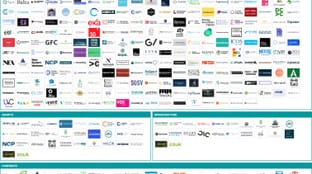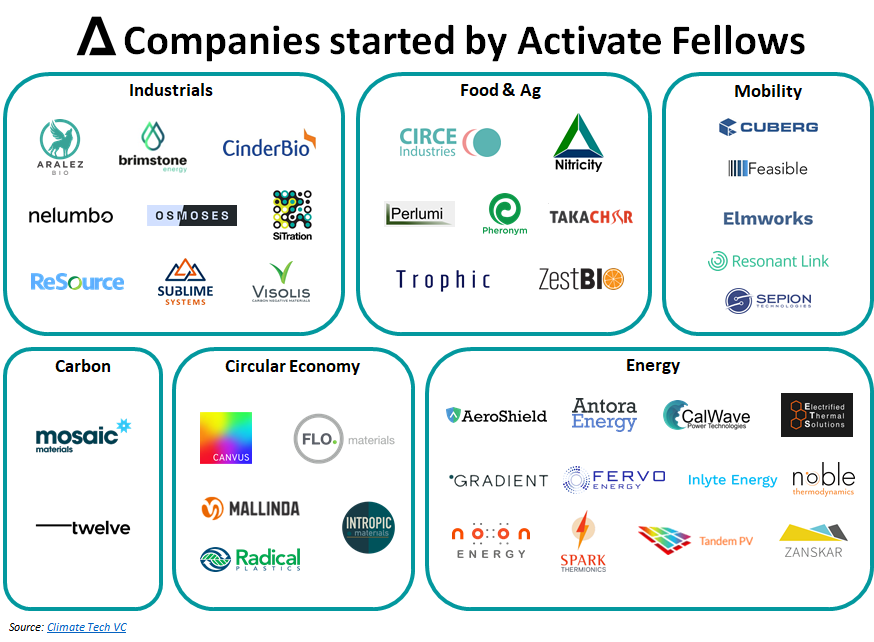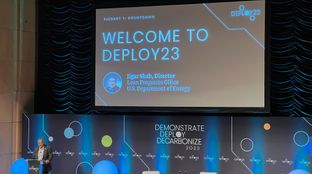
🌏 Who are the Climate Tech Investors?
A new interactive Climate Capital Stack Map
And what Stripe now has to do with it
VCs often wax poetic about the magic of “founder-market fit.” But in academia, it’s the exception not the norm that potential founders manage to bridge the science-to-market gap.
Ilan Gur, founder and CEO of Activate, puts it best: “technical ideas aren’t the limiting factor to impacting global change. The binding constraint is the lack of opportunity for an enormous pool of talented scientists to go all-in on commercializing their ideas.”
Based on his personal experience as a scientist and entrepreneur, the concept for a scientist-focused fellowship first came to Ilan while he was helping to stand up ARPA-E, the Dept of Energy’s innovation agency. At ARPA-E he observed that the most successful projects were driven by an individual who was motivated to turn their research into something productive in the real world, and aggressively pursuing technology development through company formation. Activate’s roots grew from an early commitment by Lawrence Berkeley National Laboratory and the DoE to pilot a program, called Cyclotron Road, to support entrepreneurial scientists getting in the game. Says Ilan, “That proved we could attract incredible talent and support them well in this fellowship model, empowering scientists to bring their research to market to reinvent the world. Cyclotron Road is now a research division at Berkeley Lab and we’ve scaled Activate to the national stage as an independent nonprofit. Activate supports communities of fellows at Berkeley Lab, in Boston, and anywhere in the U.S. through our Activate Anywhere program.”
“Our core premise is recognizing that new technology can make the change that we want to see in a future, better world. Rewinding that story back to the beginning, that change starts with a person who deeply understands the cutting edge science, and supporting them in turning their science into a technology. They come in the door as individuals and fellows. And ideally, they leave as leaders with a well-articulated understanding of how their products will serve the market, and ultimately serve society."
With more than 100 Activate Fellows over 7 years, Activate supports scientists working across sectors, from energy to ag to defense, to commercialize hard-tech innovations, many of which are climate tech solutions. Over the next five years, Activate plans to expand to 100 new fellows per year, most of whom will focus on climate change.
🏭 Industrials: Aralez Bio (green enzymes), Brimstone Energy (carbon-neutral cement), CinderBio (green enzymes), Nelumbo (HVAC material innovation), Osmoses (industrial separation membranes), ReSource Chemical (plastic from CO2 and biomass), SiTration (industrial separation membranes), Sublime Systems (electrochemical cement production), Visolis (bio-based manufacturing)
🌱 Food & Ag: Circe Bioscience (CO2 to fats), Nitricity (renewable nitrogen fertilizer production), Perlumi (better seeds), Pheronym (non-toxic pest management), Takachar (transforming waste biomass), Trophic (seaweed-based protein), ZestBio (food waste into products)
⚡ Energy: Aeroshield Materials (energy-efficient windows), Antora Energy (thermal energy storage), Calwave Power (wave energy), Electrified Thermal Solutions (thermal energy storage), Fervo Energy (geothermal development), Gradient (heating & cooling), Inlyte Energy (sodium-ion chloride battery), Noble Thermodynamic Systems (closed-loop reciprocating engine), Noon Energy (long-duration energy storage), Spark Thermionics (power plant on a chip), Tandem PV (perovskite & silicon tandem solar), Zanskar (geothermal exploration)
🚌 Mobility: Cuberg (lithium metal batteries), Elmworks (electromagnetic devices), Feasible (battery diagnostics), Resonant Link (wireless charging), Sepion Technologies (lithium metal batteries)
💨 Carbon: Mosaic Materials (CO2 capture material), Twelve (CO2 to chemicals)
♻️ Circular Economy: Canvus (erasable T-shirts), FLO Materials (infinitely recyclable plastics), Intropic Materials (compostable plastics), Radical Plastics (biodegradable plastics)

We asked recent Activate Fellows how the program helped them make the leap from the lab into the market.
"Activate directly enabled us to build Noon Energy, our startup developing long-duration energy storage technology to make intermittent solar and wind power available 24/7 year-round at lower cost than fossil fuels. We started from an invention and lab experiments and Activate gave us the foundation, time, and network to grow our team, attract funding, and gain market traction." Christopher Graves, Noon Energy
“Nitricity has developed a breakthrough technology that decarbonizes the production, distribution, and application of nitrogen fertilizer. Activate has been invaluable in helping Nitricity to build a world-class team, secure vital funding, and vet our business model with an awesome network of entrepreneurs and advisors.” — Josh McEnaney, Nitricity
“Activate helped get Sublime Systems and our technology to decarbonize cement production to market by connecting me with influential, open-minded, and passionate advisors from the cement industry.” — Leah Ellis, Sublime Systems
The Activate Fellowship arms science-entrepreneurs for the frontier of climate tech, including non consensus, greenfield territory like Carbon Dioxide Removal (CDR) where, as Ilan puts it, “there’s a bottleneck in the innovation pipeline, before the market pull.”
“No one feels like they own that pre-market, science interface. You don’t fall into any of the established categories, but have to engage with all the different worlds of government, venture capital, academia, and corporates. Activate has found that we can be the trusted intermediary and confidently occupy the proto-company stage, through very rigorous selection of the science entrepreneurs’ vision and technology. We have a corporate program and have innovated in new mechanisms for corporate partnerships, a venture capitalist network, and deep government funding, all entirely aligned through the lens of impact. Now for the first time, we can align impact with corporate procurement in our new Carbon Dioxide Removal Imperative coalition with Stripe.”
Through its Stripe Climate program, Stripe will purchase carbon removal from Activate Fellows' startups with promising carbon removal technologies through $500,000 procurement contracts. “Stripe knows CDR is limited in part by the concentration of talent and scalable ideas. Activate is essentially built to find that talent and turn them into viable technology solutions ready to get picked up by the marketplace. Along with the support from philanthropies funding the fellows, Stripe has made an aligned commitment to purchase up to $500k of carbon removal from startups as that core first customer to reduce market risk and accelerate towards commercialization. I'm hopeful that this program serves as a template for other climate impact areas to partner with other corporate procurement purchases in the future.”
Activate is about to open its application window for Cohort 2022: October 15 - November 30.
If you know—or are!—a scientist in that messy middle between the strictures of academia and the profit-focused market, Activate is holding events for applicants. You can nominate a potential fellow and Activate will encourage them to apply. Fellows receive a yearly living stipend of up to $110,000, plus $100,000 in research support and a program of intensive entrepreneurial training, mentorship, and networking. Activate is also expanding its partner network and its team.

A new interactive Climate Capital Stack Map

Financing around first- or early-of-a-kind project risk

‘Government-enabled, private sector-led’ in action in Washington, DC